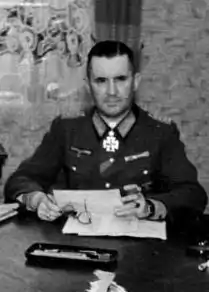Gustav Adolf von Zangen | |
|---|---|
 | |
| Born | 7 November 1892 Darmstadt, German Empire |
| Died | 1 May 1964 (aged 71) Hanau, West Germany |
| Allegiance | |
| Service/ | |
| Years of service | 1910–45 |
| Rank | General of the Infantry |
| Commands held | |
| Battles/wars | |
| Awards | Knight's Cross of the Iron Cross with Oak Leaves |
Gustav Adolf Karl Friedrich Ernst von Zangen[1] (7 November 1892 – 1 May 1964) was a German general in the Wehrmacht during World War II and a commander of the 15th Army in the Netherlands in 1944 during World War II. He was a recipient of the Knight's Cross of the Iron Cross with Oak Leaves of Nazi Germany.
Career
Born in 1892, Von Zangen joined the army and served during World War I, receiving the Iron Cross.
During World War II, he commanded the 17th Infantry Division on the Eastern Front, a Corps in France in 1943 and an Army detachment in Italy before being appointed to command the 15th Army on the Western Front. Having occupied the Pas de Calais during the 1944 campaign in France, Von Zangen was forced to evacuate his army, together with other divisions, across the Scheldt to the island of Walcheren and South Beveland.
There, they were attacked during the Battle of the Scheldt 2 October-8 November 1944. He deployed his force against the Allied advance into the Netherlands. On 24 October 1944 his headquarters in Dordrecht were bombed by the RAF. During the Ardennes offensive starting 16 December 1944, his 15th Army was tasked with fixing the British and U.S. forces north of the Bulge (see also Operation Blackcock, Operation Grenade.) Von Zangen surrendered in April 1945 in the Ruhr Pocket.
He died in 1964 in Hanau.
Awards and decorations
- Iron Cross (1914) 2nd Class (13 September 1914) & 1st Class (19 March 1915)[2]
- EK II: 13 September 1914
- EK I: 19 March 1915
- General Honor Decoration (Hesse)
- Großherzoglich Hessisches Kriegsehrenzeichen in Eisen
- Wound Badge (1914) in Black
- Rechtsritter of the Order of Saint John (Bailiwick of Brandenburg)
- Honour Cross of the World War 1914/1918
- Wehrmacht Long Service Award 4th to 1st Class
- West Wall Medal
- Clasp to the Iron Cross (2nd Class & 1st Class)[3]
- Eastern Front Medal
- Knight's Cross of the Iron Cross with Oak Leaves
References
Citations
- ↑ Correct name according to Geburtsurkunde (Geburtsregister des Standesamtes Darmstadt Nr. 1013/1892) and Heiratsurkunde (Heiratsregister des Standesamtes Darmstadt Nr. 175/1917)
- ↑ Thomas 1998, p. 468.
- ↑ "Zangen, von, Gustav-Adolf (15. Armee) - TracesOfWar.com".
- ↑ Scherzer 2007, p. 802.
- ↑ Fellgiebel 2000, p. 92.
Bibliography
- Fellgiebel, Walther-Peer (2000) [1986]. Die Träger des Ritterkreuzes des Eisernen Kreuzes 1939–1945 — Die Inhaber der höchsten Auszeichnung des Zweiten Weltkrieges aller Wehrmachtteile [The Bearers of the Knight's Cross of the Iron Cross 1939–1945 — The Owners of the Highest Award of the Second World War of all Wehrmacht Branches] (in German). Friedberg, Germany: Podzun-Pallas. ISBN 978-3-7909-0284-6.
- Scherzer, Veit (2007). Die Ritterkreuzträger 1939–1945 Die Inhaber des Ritterkreuzes des Eisernen Kreuzes 1939 von Heer, Luftwaffe, Kriegsmarine, Waffen-SS, Volkssturm sowie mit Deutschland verbündeter Streitkräfte nach den Unterlagen des Bundesarchives [The Knight's Cross Bearers 1939–1945 The Holders of the Knight's Cross of the Iron Cross 1939 by Army, Air Force, Navy, Waffen-SS, Volkssturm and Allied Forces with Germany According to the Documents of the Federal Archives] (in German). Jena, Germany: Scherzers Militaer-Verlag. ISBN 978-3-938845-17-2.
- Thomas, Franz (1998). Die Eichenlaubträger 1939–1945 Band 2: L–Z [The Oak Leaves Bearers 1939–1945 Volume 2: L–Z] (in German). Osnabrück, Germany: Biblio-Verlag. ISBN 978-3-7648-2300-9.